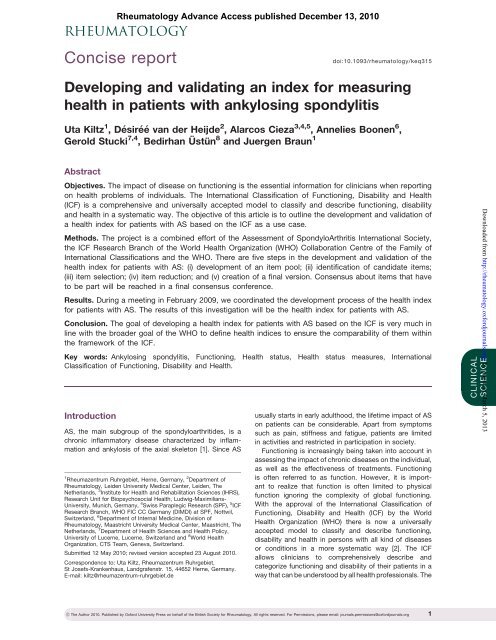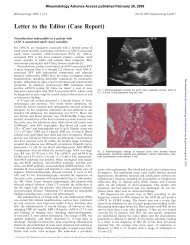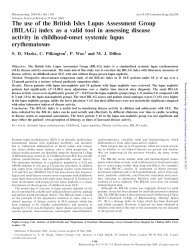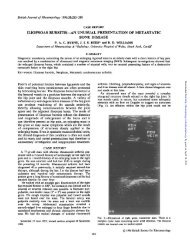Concise report - Rheumatology
Concise report - Rheumatology
Concise report - Rheumatology
Create successful ePaper yourself
Turn your PDF publications into a flip-book with our unique Google optimized e-Paper software.
<strong>Concise</strong> <strong>report</strong> doi:10.1093/rheumatology/keq315<br />
Developing and validating an index for measuring<br />
health in patients with ankylosing spondylitis<br />
Uta Kiltz 1 ,Désiréé van der Heijde 2 , Alarcos Cieza 3,4,5 , Annelies Boonen 6 ,<br />
Gerold Stucki 7,4 , Bedirhan Üstün 8 and Juergen Braun 1<br />
Abstract<br />
Objectives. The impact of disease on functioning is the essential information for clinicians when <strong>report</strong>ing<br />
on health problems of individuals. The International Classification of Functioning, Disability and Health<br />
(ICF) is a comprehensive and universally accepted model to classify and describe functioning, disability<br />
and health in a systematic way. The objective of this article is to outline the development and validation of<br />
a health index for patients with AS based on the ICF as a use case.<br />
Methods. The project is a combined effort of the Assessment of SpondyloArthritis International Society,<br />
the ICF Research Branch of the World Health Organization (WHO) Collaboration Centre of the Family of<br />
International Classifications and the WHO. There are five steps in the development and validation of the<br />
health index for patients with AS: (i) development of an item pool; (ii) identification of candidate items;<br />
(iii) item selection; (iv) item reduction; and (v) creation of a final version. Consensus about items that have<br />
to be part will be reached in a final consensus conference.<br />
Results. During a meeting in February 2009, we coordinated the development process of the health index<br />
for patients with AS. The results of this investigation will be the health index for patients with AS.<br />
Conclusion. The goal of developing a health index for patients with AS based on the ICF is very much in<br />
line with the broader goal of the WHO to define health indices to ensure the comparability of them within<br />
the framework of the ICF.<br />
Key words: Ankylosing spondylitis, Functioning, Health status, Health status measures, International<br />
Classification of Functioning, Disability and Health.<br />
Introduction<br />
<strong>Rheumatology</strong> Advance Access published December 13, 2010<br />
RHEUMATOLOGY<br />
AS, the main subgroup of the spondyloarthritides, is a<br />
chronic inflammatory disease characterized by inflammation<br />
and ankylosis of the axial skeleton [1]. Since AS<br />
1 Rheumazentrum Ruhrgebiet, Herne, Germany, 2 Department of<br />
<strong>Rheumatology</strong>, Leiden University Medical Center, Leiden, The<br />
Netherlands, 3 Institute for Health and Rehabilitation Sciences (IHRS),<br />
Research Unit for Biopsychosocial Health, Ludwig-Maximilians-<br />
University, Munich, Germany, 4 Swiss Paraplegic Research (SPF), 5 ICF<br />
Research Branch, WHO FIC CC Germany (DIMDI) at SPF, Nottwil,<br />
Switzerland, 6 Department of Internal Medicine, Division of<br />
<strong>Rheumatology</strong>, Maastricht University Medical Center, Maastricht, The<br />
Netherlands, 7 Department of Health Sciences and Health Policy,<br />
University of Lucerne, Lucerne, Switzerland and 8 World Health<br />
Organization, CTS Team, Geneva, Switzerland.<br />
Submitted 12 May 2010; revised version accepted 23 August 2010.<br />
Correspondence to: Uta Kiltz, Rheumazentrum Ruhrgebiet,<br />
St Josefs-Krankenhaus, Landgrafenstr. 15, 44652 Herne, Germany.<br />
E-mail: kiltz@rheumazentrum-ruhrgebiet.de<br />
usually starts in early adulthood, the lifetime impact of AS<br />
on patients can be considerable. Apart from symptoms<br />
such as pain, stiffness and fatigue, patients are limited<br />
in activities and restricted in participation in society.<br />
Functioning is increasingly being taken into account in<br />
assessing the impact of chronic diseases on the individual,<br />
as well as the effectiveness of treatments. Functioning<br />
is often referred to as function. However, it is important<br />
to realize that function is often limited to physical<br />
function ignoring the complexity of global functioning.<br />
With the approval of the International Classification of<br />
Functioning, Disability and Health (ICF) by the World<br />
Health Organization (WHO) there is now a universally<br />
accepted model to classify and describe functioning,<br />
disability and health in persons with all kind of diseases<br />
or conditions in a more systematic way [2]. The ICF<br />
allows clinicians to comprehensively describe and<br />
categorize functioning and disability of their patients in a<br />
way that can be understood by all health professionals. The<br />
! The Author 2010. Published by Oxford University Press on behalf of the British Society for <strong>Rheumatology</strong>. All rights reserved. For Permissions, please email: journals.permissions@oxfordjournals.org 1<br />
CLINICAL<br />
SCIENCE<br />
Downloaded from<br />
http://rheumatology.oxfordjournals.org/<br />
by guest on March 5, 2013
Uta Kiltz et al.<br />
ICF model identifies three components of the dimension of<br />
functioning, namely body functions, body structures, as<br />
well as activity and participation. To apply the ICF in practice,<br />
ICF Core Sets, which comprise specific categories<br />
relevant for a particular condition, have been developed<br />
for various diseases. Both a Brief ICF Core Set and a<br />
Comprehensive ICF Core Set have been established for<br />
patients with AS [3].<br />
Clinicians often rely on summary scores that integrate<br />
different aspects of functioning and which are usually constructed<br />
by adding up the responses to different items.<br />
Summary scores allow clinicians to estimate the overall<br />
level of functioning of patients, to monitor disease and<br />
rehabilitation management, and to follow patients along<br />
the continuum of care over the lifespan.<br />
The objective of this article is to outline the development<br />
and validation of a health index for patients with AS based<br />
on the categorical profile built on the ICF Core Set for AS<br />
as a use case.<br />
Materials and methods<br />
The development and validation of the health index for<br />
patients with AS is a combined effort of the Assessment<br />
of SpondyloArthritis International Society (ASAS), the ICF<br />
Research Branch of the WHO Collaboration Centre of<br />
the Family of International Classifications and the WHO.<br />
This effort was coordinated in a meeting held in Zurich,<br />
Switzerland on 26 February 2009. The following members<br />
from the above outlined partners were involved: A.B., J.B.,<br />
U.K., D.vdH. (all ASAS), A.C., G.S. (ICF Research Branch)<br />
and B.Ü. (WHO). Starting points that were agreed upon<br />
during this meeting and issues that have to be resolved at<br />
a later stage are described in this article. All aspects of the<br />
project will be conducted in conformity with the ethical<br />
principles of the Declaration of Helsinki. The appropriate<br />
study-related documents will be presented to the corresponding<br />
ethics committees for review and approval.<br />
Methodology<br />
There will be five steps in the development and validation<br />
of the health index for patients with AS. A summary of<br />
the methodology of the preliminary surveys and of the<br />
consensus meeting is shown in Table 1.<br />
Methodology of the development<br />
Preparatory phase (Phase I)<br />
Selection of instruments. As a starting point we will<br />
create an item pool covering the categories of the<br />
Comprehensive and Brief ICF Core Set for AS [3].<br />
The item pool will be collected from various instruments<br />
currently available for use in patients with AS,<br />
which focus on symptoms, functioning and composed<br />
measures such as questionnaires about quality of<br />
life (QoL). Questionnaires used should assesses different<br />
aspects of patients with AS. The following instruments<br />
have already been agreed upon during<br />
the meeting in Zurich: ASQoL Questionnaire; BASFI;<br />
Dougados Functional Index; EuroQoL-five dimensions<br />
(EQ5D); Functional Assessment of Chronic Illness<br />
Therapy-fatigue (FACIT-fatigue); HAQ modified for<br />
SpAs (HAQ-S); Health Utilities Index-Mark 3 (HUI-3);<br />
Hospital Anxiety and Depression Scale (HADS); Jenkins<br />
Sleep Disorder; Nottingham Health Profile; Psoriatic<br />
Arthritis QoL (PsAQoL) Questionnaire; RA-specific QoL<br />
Instrument; Revised Leeds Disability Questionnaire;<br />
Short-form 36; WHO Disability Assessment Schedule II;<br />
Work Productivity; and Activity Impairment<br />
Questionnaire– General Health [4–19]. These questionnaires<br />
may not cover the whole spectrum of the ICF<br />
Core Set for AS. In this case, we want to screen additional<br />
instruments that are not commonly used in patients with<br />
AS, but are already linked to the ICF (e.g. Daily Stress<br />
Inventory) [20].<br />
Linkage of instruments to the ICF. Some of these instruments<br />
have been already linked and the results have been<br />
published elsewhere [21–25]. Items out of the following<br />
instruments will be linked explicitly for this project:<br />
FACIT fatigue, HUI-3, HADS, Jenkins Sleep Disorder and<br />
PsAQoL. The items will be linked separately by two<br />
trained health professionals (U.K. and A.B.) according<br />
to established linking rules [26]. Consensus between the<br />
two health professionals has to be reached. To resolve<br />
disagreements between them concerning the selected<br />
categories, a third person trained in the linking rules will<br />
be consulted (A.C.).<br />
Selection of items. Items of these instruments will be<br />
selected for inclusion if they contain only one concept<br />
and if the sentences are short and simple. A preliminary<br />
estimate assumes that the item pool will consist of<br />
150 items.<br />
Adaptation of items. Each item will be adapted to the<br />
following criteria: the items should be expressed in the<br />
first person and in the present tense. As far as possible,<br />
potential items will be direct quotations from the original<br />
instruments.<br />
TABLE 1 Summary of the methodology of the preliminary surveys and of the consensus meeting<br />
Phase Objectives Methods<br />
I. Preparatory phase Development of an item pool Linkage of various assessment tools to ICF<br />
II. First postal survey Identification of candidate items Rasch analysis<br />
III. Expert survey Item selection Nominal consensus process<br />
IV. Second postal survey Validation of the draft version; Item reduction Testing psychometric properties; Rasch analysis<br />
V. Consensus meeting Creation a final version Nominal consensus process<br />
2 www.rheumatology.oxfordjournals.org<br />
Downloaded from<br />
http://rheumatology.oxfordjournals.org/ by guest on March 5, 2013
Methodology of validation<br />
First postal survey (Phase II)<br />
The objective of this step is to identify items that differentiate<br />
between persons with different levels of functioning.<br />
The item pool will be studied in a multicentre,<br />
cross-sectional study. The item pool will be split into<br />
three different sets, which will be designed for 300<br />
patients. Within the sets, there will be items that are similar<br />
in each set. These repeated items are considered<br />
to reflect basic ideas such as pain or impaired mobility,<br />
and therefore serve as comparators in the selection<br />
process.<br />
To identify candidate items the data set will be<br />
subjected to Rasch analysis to assess the overall fit of<br />
the model, individual item fit, the response scale used<br />
and the presence of differential item functioning (DIF).<br />
The fit of the data to the model is a prerequisite to construct<br />
measures. DIF assesses the effect of external factors,<br />
such as gender or age, on individual item response. It<br />
is important to demonstrate that items will not be valuated<br />
differently by subgroups. Thus, a reduced item pool will<br />
be evolved by removing items not fitting the model<br />
expectations.<br />
Expert survey (Phase III)<br />
To confirm the content validity of the items selected in<br />
Phase II, an expert survey will be performed. The steering<br />
committee together with additional invited international<br />
experts in the field of spondyloarthritis from most WHO<br />
regions will produce a draft version by means of item<br />
selection with a nominal consensus technique. In addition,<br />
we will decide on the response format on the basis of the<br />
results of the first postal survey and the results of the<br />
Rasch analysis.<br />
Second postal survey (Phase IV)<br />
The objective of this step is to test scaling properties,<br />
reliability, internal consistency and construct validity<br />
of the draft version. In a multicentre, cross-sectional<br />
study 250 AS patients will receive the draft version<br />
together with a demographic questionnaire and additional<br />
comparator measures (BASFI and HAQ-S). This package<br />
will be sent twice, 2 weeks apart, short enough to<br />
minimize change in condition over time, but long enough<br />
to minimize memory of responses. Patients will be asked if<br />
there has been a change in disease status between the<br />
first and the second questionnaire. Data from this stage<br />
will be fitted to the Rasch model to confirm that the<br />
items form a unidimensional scale, that they represent<br />
hierarchical ordering, and to confirm the absence of<br />
DIF. After performance of Rasch analysis, a revised<br />
version of the health index for patients with AS will be<br />
available.<br />
Consensus meeting (Phase V)<br />
The objective of this step is to create a final version of the<br />
health index for patients with AS. In a consensus meeting,<br />
we will discuss controversial items. Agreement will be<br />
achieved by a nominal consensus process.<br />
Results<br />
The results of this investigation will be the health index for<br />
patients with AS.<br />
Discussion<br />
Developing and validating an index<br />
The increasing recognition of functioning and health has<br />
led to an impressive effort in research to develop instruments<br />
to measure them. The ICF as a common framework<br />
for functioning is being increasingly applied in clinical<br />
research and practice. A methodological exploration has<br />
shown that it is possible to principally construct clinical<br />
measures for patients with AS based on the ICF [27].<br />
However, for the development of health indices basic requirements<br />
have to be fulfilled. The members of the WHO<br />
Functioning and Disability Reference Group are currently<br />
discussing the components: (i) comparability, (ii) metric<br />
equivalence and (iii) assessment of QoL.<br />
(i) Comparability of diseases is requested for ranking<br />
different diseases. Therefore, instruments should<br />
contain generic items not specific to AS, which<br />
will allow comparability between other diseases<br />
than AS.<br />
(ii) Metric equivalence is another prerequisite to be<br />
able to compare different instruments. Instruments<br />
with metric properties that provide summary scores<br />
across a number of ICF categories would provide<br />
clinicians with an understanding of patients’ overall<br />
level of functioning.<br />
(iii) Assessing QoL is important especially for patients<br />
with chronic disabling conditions. In the absence<br />
of a cure for the disease, information about QoL<br />
provide evidence that therapy really makes people<br />
feel better.<br />
As shown in content comparison of health-related QoL<br />
(HRQoL) instruments different aspects are scarcely represented<br />
within the instruments and many generic tools lack<br />
the precision required for effective health care decision<br />
making [23]. Based on this, ASAS started to develop an<br />
index for measurement of health in patients with AS. The<br />
aim of the ASAS Health Index is to cover all concepts of<br />
functioning relevant to patients with AS. It has been<br />
shown that only 50% of concepts important for functioning<br />
of patients with AS are covered by instruments<br />
included in the core sets of outcomes for AS or other<br />
disease-specific instruments [22]. Especially, aspects of<br />
contextual factors (such as support, attitudes of family,<br />
medication and financial assets) are not adequately<br />
covered by standard measures. But the contribution of<br />
contextual factors to functioning is important. Goordeev<br />
et al. [28] showed that contextual factors explained 37 and<br />
47% of the variance in EQ5D and ASQoL, respectively,<br />
which is in line with the finding by Dagfinrud et al. [29] that<br />
impairment variables (disease activity and pain) explained<br />
only one-third of activity and participation restrictions.<br />
As in any scientific endeavour, there are uncertainties<br />
that have to be resolved during the development process.<br />
As mentioned, inconsistencies in linking ICF items have<br />
www.rheumatology.oxfordjournals.org 3<br />
Downloaded from<br />
http://rheumatology.oxfordjournals.org/ by guest on March 5, 2013
Uta Kiltz et al.<br />
been shown in former procedures and are likely to occur<br />
within the development process of the health index.<br />
The fact that the concepts, health status, functional<br />
status, QoL and HRQoL, are often applied interchangeably<br />
in the literature is less irritating when the measures for<br />
which those concepts are applied are linked to the ICF.<br />
Since HRQoL and ICF represent two different perspectives<br />
from which to look at functioning and health, it is<br />
expected that both will often be used concurrently.<br />
The goal of developing a health index for a specific<br />
condition based on the ICF and its Core sets is very<br />
much in line with the broader goal of the WHO to define<br />
health indices with the above outlined basic requirements<br />
of instruments to ensure the comparability of them within<br />
the framework of the ICF.<br />
<strong>Rheumatology</strong> key messages<br />
. Functioning is an important aspect in patients with<br />
chronic diseases.<br />
. Valid disease-specific instruments are needed to<br />
describe functioning based on the ICF.<br />
. We described the process of instrument selection<br />
and adaptation of items.<br />
Disclosure statement: The authors have declared no<br />
conflicts of interest.<br />
References<br />
1 Braun J, Sieper J. Ankylosing spondylitis. Lancet 2007;<br />
369:1379–90.<br />
2 The International Classification of Functioning, Disability<br />
and Health. WHO, Geneva, 2001.<br />
3 Boonen A, Braun J, van der Horst Bruisma I et al. The<br />
ASAS/WHO ICF core sets for ankylosing spondylitis: how<br />
to classify the impact of AS on functioning and health. Ann<br />
Rheum Dis 2010;69:102–7.<br />
4 Doward LC, Spoorenberg A, Cook SA et al. Development<br />
of the ASQoL: a quality of life instrument specific to<br />
ankylosing spondylitis. Ann Rheum Dis 2003;62:20–6.<br />
5 Calin A, Garrett S, Whitelock H et al. A new approach to<br />
defining functional ability in ankylosing spondylitis: the<br />
development of the Bath ankylosing spondylitis functional<br />
index. J Rheumatol 1994;21:2281–5.<br />
6 Dougados M, Guguen A, Nakache JP, Ngyen M, Mery C,<br />
Amor B. Evaluation of a functional index and an articular<br />
index in ankylosing spondylitis. J Rheumatol 1988;2:<br />
302–7.<br />
7 The EuroQoL group. EuroQoL – a new facility for the<br />
measurement of health related quality of life. Health Policy<br />
1990;16:199–208.<br />
8 Cella D. Manual of the Functional Assessment of Chronic<br />
Illness Therapy (FACIT) measurement system. Evanston,<br />
IL: Center on Outcomes, Research and Education (CORE),<br />
Evanston Northwestern Healthcare and Northwestern<br />
University, 1997.<br />
9 Daltroy LH, Larson MG, Roberts NW, Liang MH. A<br />
modification of the health assessment questionnaire for<br />
the spondyloarthropathies. J Rheumatol 1990;17:946–50.<br />
10 Horsman J, Furlong W, Feeny D, Torrance G. The health<br />
utilities index (HUI): concepts, measurement properties<br />
and applications. Health Qual Life Outcomes 2003;I:54.<br />
11 Zigmond AS, Snaith RP. The hospital anxiety and<br />
depression scale. Acta Psychiatr Scand 1083;76:361–70.<br />
12 Jenkins CD, Stanton BA, Niemcryk SJ, Rose RM. A scale<br />
for the estimation of sleep problems in clinical research.<br />
J Clin Epidemiol 1988;41:313–21.<br />
13 Hunt SM, McEwen J, McKenna SP. Measuring health<br />
status: a new tool for clinicians and epidemiologists.<br />
J R Coll Gen Pract 1985;35:185–8.<br />
14 McKenna Sp, Doward LC, Whalley D, Tennant A, Emery P,<br />
Veale DJ. Development of the PsAQoL: a quality of life<br />
instrument specific to psoriatic arthritis. Ann Rheum Dis<br />
2004;63:162–9.<br />
15 De Jong Z, van der Heijde D, McKenna SP, Whalley D.<br />
The reliability and construct validity of the RAQoL: a<br />
rheumatoid arthritis-specific quality of life instrument.<br />
Br J Rheumatol 1997;36:878–83.<br />
16 Abbott CA, Helliwell PS, Chamberlain MA. Functional<br />
assessment in ankylosing spondylitis: evaluation of a<br />
new self-administered questionnaire and correlation<br />
with anthropometric variables. Br J Rheumatol 1994;33:<br />
1060–6.<br />
17 Ware JE Jr, Sherbourne CD. The MOS 36-item short-form<br />
health survey (SF-36). I. Conceptual framework and item<br />
selection. Med Care 1992;30:473–83.<br />
18 WHODAS-II. Disability assessment schedule training<br />
manual: a guide to administration. World Health<br />
Organization: classification, assessment and survey team<br />
(CAS); Global Programme on Evidence for Health Policy<br />
(GPE). Geneva: WHO, 2000.<br />
19 Reilly MC, Zbrozek AS, Dukes EM. The validity and<br />
reproducibility of a work productivity and activity impairment<br />
instrument. Pharmacoeconomics 1993;4:353–65.<br />
20 Brantley PJ, Waggoner CD, Jones GN, Rappaport NB.<br />
A daily stress inventory: development, reliability, and<br />
validity. J Behav Med 1987;10:61–74.<br />
21 Cieza A, Hilfiker R, Boonen A et al. Items from<br />
patient-oriented instruments can be integrated into<br />
interval scales to operationalize categories of the<br />
International Classification of Functioning, Disability<br />
and Health. J Clin Epid 2009;62:912–21.<br />
22 Boonen A, van Berkel M, Cieza A, Stucki G,<br />
van der Heijde D. Which aspects of functioning are<br />
relevant for patients with ankylosing spondylitis: results<br />
of focus group interviews. J Rheumatol 2009;36:<br />
2501–11.<br />
23 Cieza A, Stucki G. Content comparison of health-related<br />
quality of life (HRQoL) instruments based on the international<br />
classification of functioning, disability and health<br />
(ICF). Qual Life Res 2005;14:1225–37.<br />
24 Sigl T, Cieza A, van der Heijde D, Stucki G. ICF based<br />
comparison of disease specific instruments measuring<br />
physical functional ability in ankylosing spondylitis.<br />
Ann Rheum Dis 2005;64:1576–81.<br />
25 Escorpizo R, Cieza A, Beaton D, Boonen A. Content<br />
comparison of worker productivity questionnaires in<br />
4 www.rheumatology.oxfordjournals.org<br />
Downloaded from<br />
http://rheumatology.oxfordjournals.org/ by guest on March 5, 2013
arthritis and musculoskeletal conditions using the<br />
international classification of functioning, disability, and<br />
health framework. J Occup Rehabil 2009;36:2057–60.<br />
26 Cieza A, Brockow T, Ewert T et al. Linking health-status<br />
measurements to the international classification of functioning,<br />
disability and health. J Rehabil Med 2002;34:<br />
205–10.<br />
27 Cieza A, Hilfiker R, Boonen A, van der Heijde D, Braun J,<br />
Stucki G. Towards an ICF-based clinical measure of<br />
functioning in people with ankylosing spondylitis: a<br />
Developing and validating an index<br />
methodological exploration. Disabil Rehabil 2009;31:<br />
528–37.<br />
28 Goordeev VS, Maksymowych WP, Evers SM, Ament A,<br />
Schachna L, Boonen A. The role of contextual factors on<br />
health-related quality of life in ankylosing spondylitis. Ann<br />
Rheum Dis 2010;69:108–12.<br />
29 Dagfinrud H, Kjeken I, Mowinckel P, Hagen KB, Kvien TK.<br />
Impact of functional impairment in ankylosing spondylitis:<br />
impairment, activity limitation, and participation restrictions.<br />
J Rheumatol 2005;32:516–23.<br />
www.rheumatology.oxfordjournals.org 5<br />
Downloaded from<br />
http://rheumatology.oxfordjournals.org/ by guest on March 5, 2013















